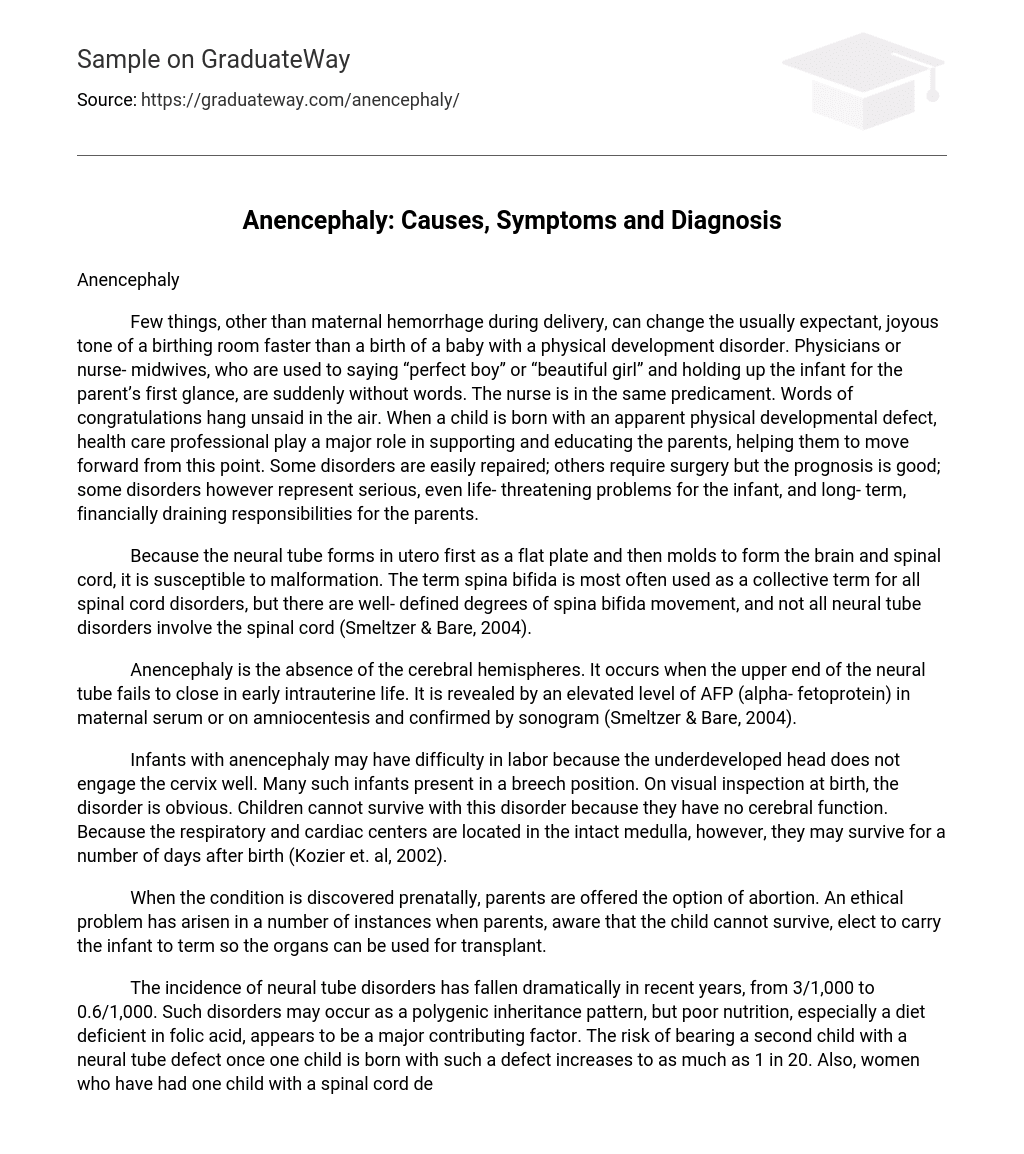Anencephaly
Few things, other than maternal hemorrhage during delivery, can change the usually expectant, joyous tone of a birthing room faster than a birth of a baby with a physical development disorder. Physicians or nurse- midwives, who are used to saying “perfect boy” or “beautiful girl” and holding up the infant for the parent’s first glance, are suddenly without words. The nurse is in the same predicament. Words of congratulations hang unsaid in the air. When a child is born with an apparent physical developmental defect, health care professional play a major role in supporting and educating the parents, helping them to move forward from this point. Some disorders are easily repaired; others require surgery but the prognosis is good; some disorders however represent serious, even life- threatening problems for the infant, and long- term, financially draining responsibilities for the parents.
Because the neural tube forms in utero first as a flat plate and then molds to form the brain and spinal cord, it is susceptible to malformation. The term spina bifida is most often used as a collective term for all spinal cord disorders, but there are well- defined degrees of spina bifida movement, and not all neural tube disorders involve the spinal cord (Smeltzer & Bare, 2004).
Anencephaly is the absence of the cerebral hemispheres. It occurs when the upper end of the neural tube fails to close in early intrauterine life. It is revealed by an elevated level of AFP (alpha- fetoprotein) in maternal serum or on amniocentesis and confirmed by sonogram (Smeltzer & Bare, 2004).
Infants with anencephaly may have difficulty in labor because the underdeveloped head does not engage the cervix well. Many such infants present in a breech position. On visual inspection at birth, the disorder is obvious. Children cannot survive with this disorder because they have no cerebral function. Because the respiratory and cardiac centers are located in the intact medulla, however, they may survive for a number of days after birth (Kozier et. al, 2002).
When the condition is discovered prenatally, parents are offered the option of abortion. An ethical problem has arisen in a number of instances when parents, aware that the child cannot survive, elect to carry the infant to term so the organs can be used for transplant.
The incidence of neural tube disorders has fallen dramatically in recent years, from 3/1,000 to 0.6/1,000. Such disorders may occur as a polygenic inheritance pattern, but poor nutrition, especially a diet deficient in folic acid, appears to be a major contributing factor. The risk of bearing a second child with a neural tube defect once one child is born with such a defect increases to as much as 1 in 20. Also, women who have had one child with a spinal cord defect are advised to have a maternal serum assay or amniocentesis of alpha- fetoprotein levels to determine if such a defect is present in second pregnancy (Pillitteri, 2003).
References:
Kozier B., Erb G., Blais K., and Wilkinson J. M. (2002).Fundamentals of nursing: Concepts process and practice (5th Ed.). Singapore: Pearson Ed. Asia Pte. Ltd.
Smeltzer, Suzanne, and Brenda G. Bare. (2004).Medical- Surgical Nursing. Lippincott Williams & Wilkins.
Pillitteri, Adele. (2003). Maternal and Child Health Nursing. Lippincott Williams & Wilkins.





